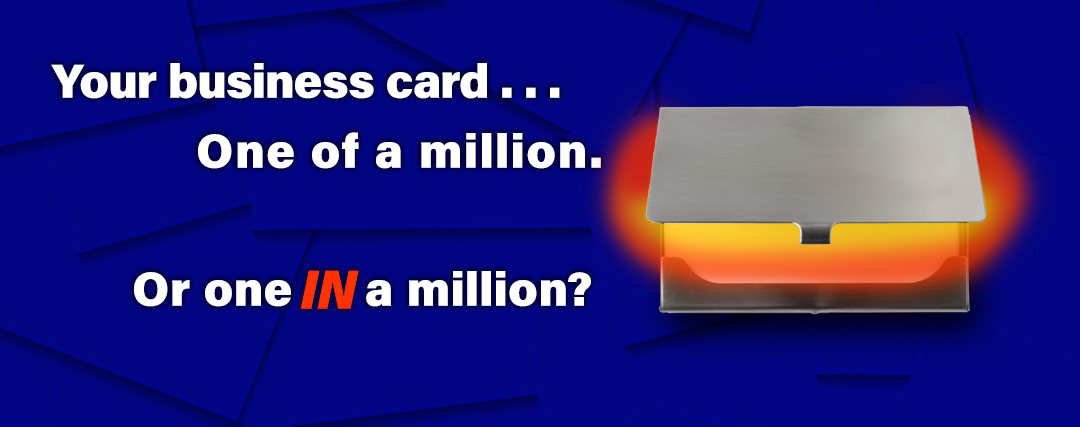Business cards are kind of like belly buttons — everybody’s got one. But UNLIKE belly buttons, they’re not extraneous or immaterial, and if you don’t have one, you need one! Full disclosure: A childhood friend of mine did NOT have a belly button, as it had been removed. I’ll spare you the details.
Business cards are the “last bastion” of collateral that businesspeople still do get printed (but there ARE other options. See below!)
Business cards are “Your Little Emissary.” They’re useful little blighters that are best kept tucked in pockets, totes, briefcases, purses — so they’re on hand when you need them instead of forgotten in a desk drawer. They’re indispensable in that they can be there when you’re not.
Historically, they’ve done some “heavy lifting” as far as packing a lot of information into a very small area, and the demands in that regard are even greater than ever. Beyond your logo, company name, name and title, and the standard contact information of phone, email and web or social media addresses, business cards can now include a scannable QR Code that can communicate just about any information and/or experience that you care to program into them.
Speaking of programming — Forget the QR code! Now you can embed an NFC chip into your business card that will hand along your contact information, launch an app, or take the recipient to an online 3D virtual tour with a single tap to an NFC-enabled device. So you can share it all in a volume of information that no merely-printed card can achieve. A simple QR code that goes to your website might be all you’d need, though, as your website can be the portal to all the rest.
Truth be told — Forget the card! Your smartphone can BE your business card, using an app to transmit all your contact information from your phone via an on-screen QR Code, email, or even text. AKA virtual, electronic, mobile, or digital business cards, this method can take care of it all. If both you AND your prospects are technology-forward, that’d be the way to go.
For those of us who still appreciate a tactile experience — Business cards can be produced in a dizzying array of sizes, shapes, and materials. Yes, the standard rectangular 3.5 x 2 inch card is still predominant and very handy, and of course laid out in a horizontal or vertical orientation. Cards can also be flat, folded, laser- or die-cut. They can be square, with rounded corners, or even simply round. They can be “mini” sized, or come in any shape you wish. They’re made with papers (as well as other materials or “substrates”) of all kinds, weights, and finishes — glossy, satin, silk, “soft-touch,” “suede,” even the old-fashioned “linen” finish. They can be edge-painted, thick or lightweight, metal, plastic, transparent, translucent, magnetic, embossed, debossed, foil-stamped, or UV coated or spot-coated. Classic letterpress is also still out there for a totally high-end, craft-oriented statement. As for inks and “special effects?” The sky’s the limit with holographic, metallic, fluorescent, varnishes (clear or tinted), and more. And speaking of letterpress or engraving, the old “poor man’s engraved” look called thermography (“raised ink”) is still out there as well. Not that I’ve ever been a big fan of it, but it does have its place. I’ll admit that my least-favorite combination has always been a “linen” finish business card with thermographic printing. Even when it was ubiquitous, I always found it vaguely irksome. Paper masquerading as fabric and heat-applied powdered ink masquerading as “engraving.” Ech.
So there we have it — the hardest-working item in the business arena, the tiny, the humble, the ever-present and always useful BUSINESS CARD.
Etiquette and Protocol
As C-3PO would tell you, there IS an etiquette and protocol to business-cardery (Not a typo! I made up a new phrase.) So anyway, there are certain things to do and not-do with business cards both in giving and in receiving them. And there’s some great advice out there. Exchanging business cards can be done with finesse. It’s a literal matter of give-and-take, as are most things when it comes to etiquette. There are even cultural considerations. For example, it’s best not to take a business card out of the hands of a Japanese businessperson with just one hand. You should — at minimum — face them and receive their card with both hands. Imagine how respectful this would feel to the person giving you their card if you receive the card from a Japanese businessperson who you meet here in the US.
Resources
Digital Business Cards
9 Best Digital Business Card Apps For 2023
Business Card Etiquette
Business Card Etiquette: 6 Rules to Remember When Giving and Receiving Business Cards
Business Card Etiquette Around the World
Business Card Etiquette in Japan – How to Exchange Business Cards

